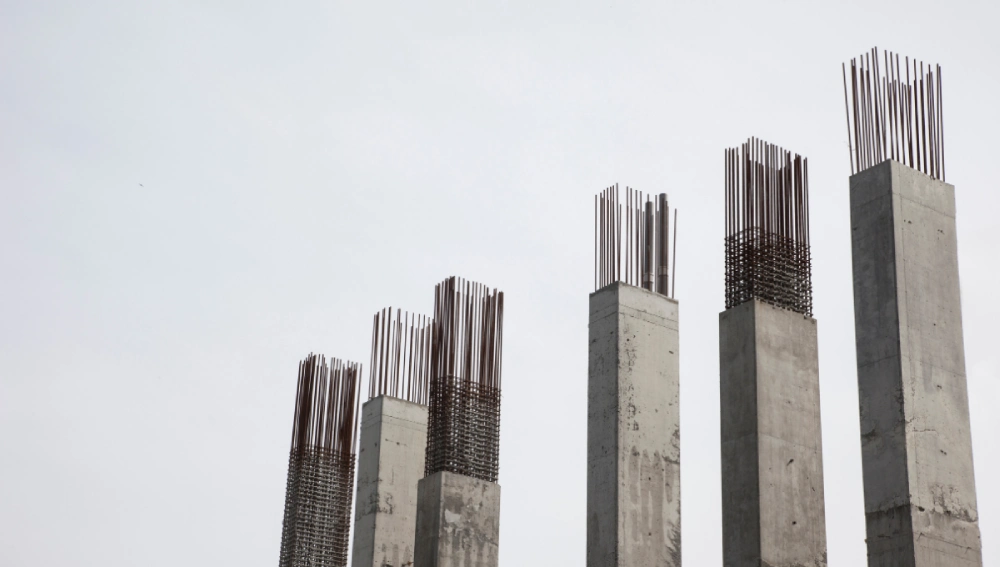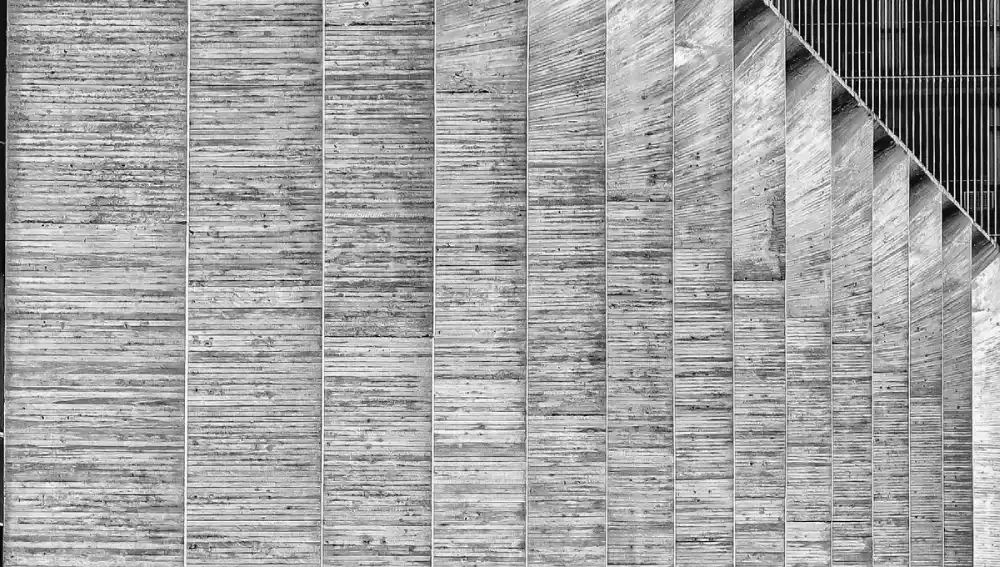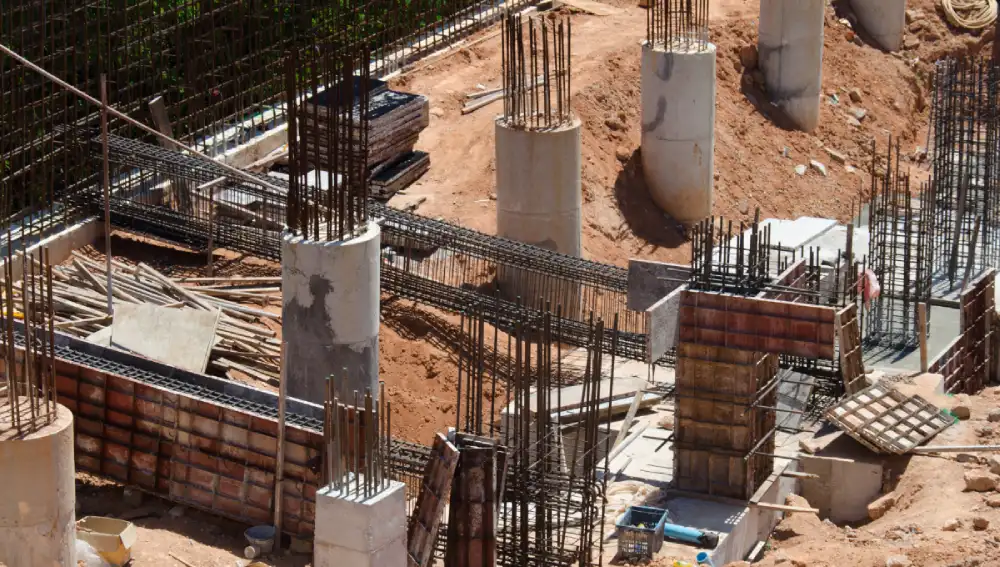Columns are a fundamental element of any building – a vertical structural component that carries load from the slabs and beams of a building to the foundation. The compressive loads created in a structure are carried to the footings and then to the soil. The failure of a column may lead to instant collapses in the structure.
There are various types of columns, including Rectangular Column, RCC Column, Circular Column, Spiral Column, etc. Choosing the right type of column according to the construction requirements typically enhances the building’s stability and longevity.
The strength of a column is determined by numerous factors, such as cross-section size, material incorporated, its geometry, and the length and position of both ends. In this article, we will discuss the column types in detail along with their significance.
Purpose of Columns

Columns in construction act as vertical support for the structures. Some of their primary purposes are listed below:
- Maintaining Stability: By using columns, the overall stability of the building can be improved by efficiently channeling the loads. It prevents walls from bulging and collapsing due to their own weight or any extra forces.
- Supporting Floors and Roofs: Columns play a crucial role in supporting the weight of floors, roofs, and ceilings by directly transmitting them to the foundation. The loads are equally distributed to the ground, resulting in no structural damage.
- Transferring Weight: Columns are capable of bearing the weight of structures, including roofs, beams, floors, or any other additional loads. This is possible by transferring the weight to the foundation, i.e., the ground.
Types of Columns

Columns are classified into various types based on their shape, loading, length, etc. They are stated below:
1. Column Types Based on the Shape
a) Circular Column
A circular column is a cylindrical structure that supports vertical loads in buildings and other constructions. It has good deflection resistance and is mostly used to support and elevate buildings. For aesthetic purposes, round columns can be widely spotted at the piling and elevation of the structures.
It significantly provides higher bending resistance compared to rectangular or square columns. This can be achieved by using more than four steel bars as reinforcement.
Circular columns are commonly used in commercial buildings and public structures where aesthetics are important, such as in atriums, lobbies, or exterior facades. They are also frequently used in infrastructure projects like bridges and flyovers due to their higher bending resistance.
b) Square or Rectangular Column
Rectangular or square columns are pretty easy to construct compared to circular columns. These types of columns are primarily used in building construction due to their characteristics, like easy shuttering and reinforcement replacement. If cost is a major concern, then this is a prime choice to be considered.
These columns are widely used in residential buildings, particularly in load-bearing walls and as primary structural supports. They are also a cost-effective choice for commercial buildings, especially in areas where construction speed and cost efficiency are prioritized, like office spaces or shopping malls.
c) T Type Column
The T Type column is incorporated with the same features as a square or rectangular column, which helps to meet the desired structural design. It is commonly used in bridge and retaining wall construction.
T-type columns are used in bridge construction and retaining walls, where they help manage horizontal loads and provide stability. They are also utilized in certain commercial buildings, especially in parking structures or underpass sections where load distribution is critical.
d) L Type Column
The L-type column is used at the corners of boundary walls in a framed structure that has an L-shaped cross-section. Though it is unpopular, it acts as a good replacement to resist both biaxial bending and axial compression of corners.
These columns are particularly effective in residential buildings, especially at the corners of boundary walls or in corner areas of structures where they help resist both biaxial bending and axial compression. They can also be used in smaller commercial buildings where space constraints require creative load distribution.
e) Y-Shaped Column
These are generally made of reinforced concrete or steel, which offers extreme strength and durability. This Y-shaped column spreads the load more evenly, which makes the column more efficient. It typically reduces the amount of material needed and is most commonly used in bridge and flyover construction.
They are also sometimes used in unique architectural designs in commercial buildings to create visually striking support structures.
2. Column Types Based on the Types of Loading
a) Axially Loaded Column
An axially loaded column carries a straight vertical load directly along its center line. Achieving a perfect alignment with the cross-sectional center of gravity is quite impractical due to imperfections or manufacturing tolerances. However, the deviations from the center of gravity are more likely to introduce bending moments in the column.
These columns are common in both residential and commercial buildings where the load is evenly distributed. They are particularly useful in simple, straightforward structures like single-story homes or straightforward office layouts.
b) Biaxial Eccentric Loading
In this biaxial eccentric loading, the vertical load on the column does not corresponding to the center of gravity of the column cross-section. It doesn’t act on either the X-axis or the Y-axis. An example is when a corner column has two beams joining at its top at right angles, but not along either x or y axes.
These columns are typically used in multi-story commercial buildings, particularly in corner positions where beams meet at right angles. They are essential in structures that require careful management of bending forces, such as skyscrapers or large industrial facilities.
c) Uniaxial Eccentric Loading
Rather than acting at the center of gravity, the vertical loads on uniaxial eccentric columns operate eccentrically on either the X or Y axis. However, a column supporting a heavy load is not evenly loaded, carrying more weight on one side.
Uniaxial eccentric loaded columns are often used in buildings with uneven load distribution, such as residential complexes with varying room sizes or commercial buildings with asymmetrical layouts. They help effectively manage the imbalance in load distribution.
3. Column Types Based on Materials
a) Steel Column
Steel columns are a go-to choice for constructions that require exceptional strength and slender profiles. They are suitable for high-rise structures and long-span constructions like bridges.
These columns are ideal for high-rise commercial buildings, industrial facilities, and bridges where strength and durability are paramount. Steel columns are also favored in modern architectural designs for their ability to support large spans without bulk.
b) Timber Column
It is a vertical structural element made from engineered wood or solid wood products. Commonly used in houses or low-rise structures to support weight and transfer it to the foundation of a building. The primary function of this column is to add a natural and warm aesthetic look to the space.
Timber columns are primarily used in residential buildings and low-rise structures, particularly in eco-friendly or rustic designs. They are also used in small commercial buildings like lodges, cafes, or boutique shops where a warm, natural look is desired.
c) Brick Column
A brick column is another vertical structural element made of brick and mortar. It can be accomplished in various shapes and sizes to support porches, roofs, and any heavy loads. Its look can be leveraged with different types of brickwork and is an ideal option to add additional fire safety to warehouses and industrial buildings.
Brick columns are commonly used in residential buildings, particularly in older or traditional-style homes. They are also popular in industrial buildings and warehouses where fire resistance is a priority. Brick columns add a classic aesthetic and structural integrity to porches and verandas as well.
4. Column Types Based on Slenderness Ratio
a) Short Column
A short column has a relatively small ratio of the effective length of the column to its least lateral dimension (slenderness ratio). It means that they are extremely shorter and stockier than its width. A short column primarily experiences compressive stress while loading and collapses due to crushing in case of failure.
Short columns are often used in residential buildings and low-rise commercial buildings, where the focus is on compressive strength rather than slenderness. They are ideal for supporting heavy loads in compact structures like bungalows or small office buildings.
b) Long Column
A long column, on the other hand, has a high ratio of effective length to its least lateral dimension. Compared to their width, they are significantly longer and slender. It causes bending that allows the column to witness a lack of stability and strength upon failure. This type of column requires careful consideration of buckling resistance to improve its ability to resist bending.
Long columns are commonly used in tall buildings and structures where height is a significant factor, such as high-rise residential complexes, office towers, and industrial chimneys. They require careful consideration of buckling resistance to ensure stability under load.
Conclusion
Columns are not just a structural element; they are more than just a supportive material. This article is entailed with different types of columns that assist engineers and architects in making informed decisions. From robust strength to elegance, each type is used for a specific purpose with unique advantages. Understanding its type ensures achieving the desired results. It is advisable to consult structural engineers to design ideal column types and sizing.
FAQs
Choosing the right column type empowers your structures to perform well for a long time by actively transferring their load to the ground. Based on the following factors, the qualities of columns can differ:
* Materials
* Shape
* Types of Loading
* Slenderness ratio
It is advisable to consult structural engineer to design ideal column types and sizing based on specific project requirements.
Depending on the type of material, the columns are categorized into different types. Each has its own unique significance and is explained below:
* Steel: highly strong and durable, good for long spans
* Brick: durable, fire-resistant, and aesthetic look
* Timber: made from solid wood, lightweight, renewable source, and warm aesthetic
1. With so many options, how do I choose the right column type?
Choosing the right column type empowers your structures to perform well for a long time by actively transferring their load to the ground. Based on the following factors, the qualities of columns can differ:
- Materials
- Shape
- Types of Loading
- Slenderness ratio
It is advisable to consult structural engineers to design ideal column types and sizing based on specific project requirements.
2. What are the advantages of different column materials?
Depending on the type of material, the columns are categorized into different types. Each has its own unique significance and is explained below:
- Steel: highly strong and durable, good for long spans
- Brick: durable, fire-resistant, and aesthetic look
- Timber: made from solid wood, lightweight, renewable source, and warm aesthetic

